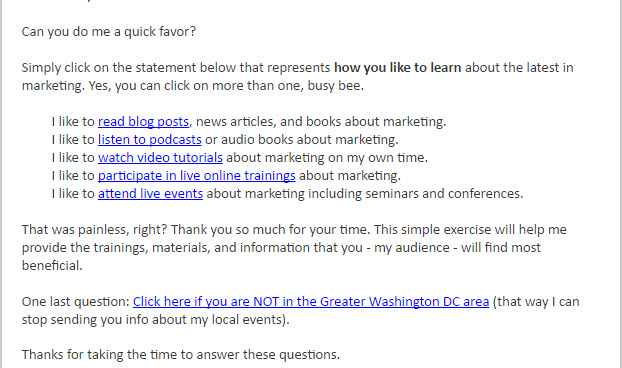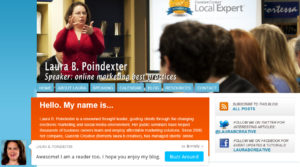Do you want to know what your audience wants? You should ask them.
But, you may have reservations about conducting a survey even if it’s just a few questions.
Over the past year, I have gained incredible insight into my audience by using a simple technique I call the faux survey (H/T to Digital Marketer for the term).
What’s a faux survey? It’s one question in the text of an email with multiple choice answers.
[We should note that Constant Contact does have a great survey tool that I use with my clients as well but sometimes I only have one question or I want immediate results. When that is the case, I use the faux survey.]
I ask one question in the text of an email and then list the multiple choice answers. I create different hyperlinks for each of the answers. This not only makes the survey results as easy as checking my click through rates but it also gives me added marketing exposure because my audience is now going where I want them to go.
You can also create a simple 2 or 3 answer faux survey using images like this example for a restaurant:
| How was your meal? | |
 |
 |
Sounds easy, right? But does it work? Of course, or I wouldn’t be writing about it.
Here are a few case studies for you:
Case Study 1: Content Consumption by Laura B. Poindexter
I wanted to know how my audience consumed content. I really wanted to start a podcast. I listen to podcasts. I love them. I started out my career in radio. I love to talk. I really thought podcasting was for me. So, I asked my audience.
Here’s the email:

Curious about my results? Considering I speak a lot both at live events and through webinars, I knew those 2 would score well. That is how I have built my list so it makes sense. The only result that really surprised me was the answer for podcasting. Can you guess how many people listen to podcasts? 1.92% That’s it. I was so sad. I mean there are always arguments for why I might want to podcast like to reach a new/different audience, but this is MY audience. This list is how I have built my business over the last 16 years. Surely I should start with what they are telling me.
The good news: think of all the time and money I didn’t waste on launching my own podcast. Now, I still love podcasts and it’s not off the table forever, just for right now. However, I am happy to dip my toe in the water (with little investment on my part) by being a guest on other people’s podcasts.
Added Benefit
The added benefit of this strategy is in the link locations. Not only are you training your audience to click on your emails but you can also send them wherever you want through the link, just be sure it’s relevant. For the survey above, answering “I like to read blog posts” would take you here:
See the note at the bottom? I used Sniply to add the note at the bottom which helped to explain why they were redirected.
But wait, there’s more…after a few weeks, I went back into the email reporting and segmented the respondents into new lists based on their answers. If I ever launch a podcast, you can bet that handful of people will be the first to know.
I also took this opportunity to ask a bonus question for those not in the Washington DC area and sent them to my webinar calendar. I also then removed them from my local events list.
I like to say marketing is just about staying in front of your audience until they are ready to buy your product or service. (click on the bird to tweet that)
This email received an initial 25% open rate and a 16% click through rate. And to improve results, I used this strategy to Increase My Open Rate by 30% (which it did) bringing the total open rate to over 30%.
I’d say that’s LOTS of positives above and beyond the info I gained, just by strategically asking one question.
Case Study 2: Net Promoter Score, Data Services Company
My client wanted to implement a Net Promoter Score survey and track their results with clients post contract completion.
So we implemented a simple faux survey that asked if they were likely to recommend the business to anyone. As per Net Promoter Score standard, scores between 0-6 are Detractors (so there was a problem), 7-8 are labeled Passives (they are happy but not likely to promote), 9-10 are Promoters (also know as your raving fans). We set up 3 landing pages with the following messaging:
Scores 9-10: Thank you so much, here’s how you can recommend us with clickable links
Scores 7-8: Thank you for your business. Let us know if we can help you in the future.
Scores 0-6: We are sorry to hear that we did not exceed your expectations, please contact us if there is anyway for us to serve you better. This page included a link t0 book a phone call directly with the CEO.
So you can see how powerful this simple strategy can be for your organization.
I’d love to know how you plan to implement a faux survey in your organization and if you felt this was helpful, please let me know in the comments below.
If you’d like more helpful tips like this and access to me to answer your questions, please join my free Facebook Group for small businesses and nonprofit marketers at www.marketing-hive.com.

